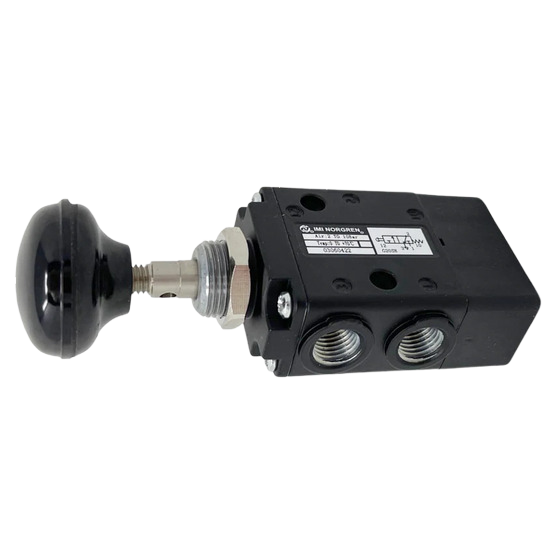What is the difference between 2 way and 3 way solenoid valves?
16.08.2024
Solenoid valves are essential components in industrial automation systems, where they control the flow of gases and liquids with precision. Industries like chemical processing and manufacturing depend heavily on these electrically operated valves for their reliability and efficiency. Among the various types available, 2-way and 3-way solenoid valves are the most widely used. Understanding the key differences between these two types is crucial for optimizing system performance and ensuring consistent, dependable operations.
2-Way Solenoid Valves
The 2 way solenoid valves is a straightforward yet vital component in many automation and industrial systems. It functions as an electrically controlled on/off switch, regulating the flow of fluids with precision and reliability.

Its operation:
Components of a two way solenoid
- Solenoid Coil: An electromagnetic coil that, when charged, produces a magnetic field.
- Plunger or Spool: A movable part within the valve body, connected to the solenoid coil.
- Valve Body: The housing that contains the internal components.
- Inlet and Outlet Ports: The points where fluid enters and exits the valve.
De-energized State:
The plunger or spool is in its default position when the solenoid coil is not receiving any electrical current.
- 2 solenoid valve normally closed(NC): The plunger blocks the flow of fluid, preventing it from passing through the valve.
- Normally Open (NO) Valve: The plunger allows fluid to flow freely through the valve.
Energized State:
When an electrical current is applied to the solenoid coil, it generates a magnetic field. This magnetic field exerts a force on the plunger or spool, causing it to move.
- NC Valve: The plunger is lifted, allowing fluid to flow through the valve.
- NO Valve: The plunger is pushed down, blocking the flow of fluid.
2way solenoid valve operation, showing the difference between energized and deenergized states for both NC and NO valves
Key Points to Remember
- Normally Closed (NC): Fluid flow is blocked when the valve is de-energized.
- Normally Open (NO): Fluid flow is allowed when the valve is de-energized.
The choice between NC and NO depends on the specific application requirements.
Your ability to select and utilize 2-way solenoid valves in your applications with efficiency will be aided by these basic concepts.
3-Way Solenoid Valves
There are three ports on a 3 way solenoid valves: an inlet, an outlet, and a common port. The purpose of the valve is to control the fluid flow between these ports.

The elements of a three way solenoid valve
- Solenoid Coil: When charged, produces a magnetic field.
- Plunger or Spool: Moves within the valve body, controlled by the solenoid coil.
- Valve Body: Contains the internal parts.
- Inlet, Outlet, and Common Ports: Points for fluid entry, exit, and distribution.
The intended flow pattern and the valve configuration—normally open or typically closed—determine the precise mode of operation of a three-way solenoid valve. However, the basic concept involves manipulating the plunger or spool to regulate the flow of fluid.
Normally Closed (NC):
- The plunger allows flow through the common port when it is de-energized, obstructing the flow from the input to the output.
- The plunger moves when it is energized, permitting flow via the common port but preventing flow from the intake to the exit.
3 way normally open solenoid valve(NO):
- The plunger permits flow from the input to the outlet when it is de-energized.
- The plunger moves when it is energized, directing flow through the common port and obstructing flow from the inlet to the outlet.
Other Configurations:
- Directional Control: Allows for multiple flow patterns based on the valve's position.
- Multi-Purpose: Can be configured for various flow patterns.
2 way vs 3 way valves
Let's compare the primary technical features of 2 port vs 3 port valve in order to better comprehend their differences:
| Feature | 2-Way Solenoid Valve | 3-Way Solenoid Valve |
| Number of Ports | 2 (inlet, outlet) | 3 (inlet, outlet, common) |
| Function | On/off control | Directs flow in two paths (mixing or diverting) |
| Flow Pattern | Simple on/off | More complex, depending on configuration |
| Applications | Simple control systems (e.g., water supply, gas control) | Complex systems (e.g., mixing, diverting) |
| Complexity | Simpler design | More complex design |
| Cost | Generally lower | Generally higher |
While 3-way valves offer greater flexibility, there are instances where a 2-way valve is the more suitable choice:
- Simplicity: 2-way valves are simpler in design and operation, which can lead to lower costs and increased reliability in some applications.
- On/off Control: When basic on/off control is required, a 2-way valve is sufficient and more cost-effective than a 3-way valve.
- Space Constraints: In applications with limited space, a 2-way valve might be the better option due to its smaller size.
Use and Fluids for 2 way and 3 way valve
To further illustrate the versatility and specific applications of 2-way and 3-way solenoid valves, let's examine their typical areas of use and the types of fluids they can handle:
| Feature | 2-Way Solenoid Valve | 3-Way Solenoid Valve |
| Suitable Fluids | Water, air, oil, and other compatible fluids | Water, air, oil, chemicals, and other compatible fluids |
| Areas of Use | Plumbing, HVAC, pneumatic systems, general industrial applications | Chemical processing, food and beverage, hydraulic systems, HVAC, pneumatic systems |
The comparison table highlights the 2-way valves excel in simple on/off control for basic systems, 3-way valves offer greater versatility for complex fluid handling processes.
Choose Between 2 way vs 3 way solenoid valve
To get the best possible system performance and efficiency, it is essential to choose the appropriate solenoid valve for your application.
1. Number of Ports
- 2-way valves have two ports: an outlet and an inlet that function as a basic on/off switch.
- 3-way valves have three ports: a common port, an exit, and an input, enabling more intricate flow control.
2. Flow Control Function
- 2-way valves are suitable for simple open/close operations, such as controlling the flow of water to a faucet.
- 3-way valves are used for more complex functions like mixing, diverting, or switching fluids between two paths.
3. Flow Pattern
- 2-way valves offer a straightforward on/off flow pattern.
- 3-way valves provide various flow patterns based on their configuration, including mixing, diverting, and directional control.
4. Fluid Compatibility
Both valve types can handle a wide range of fluids, including water, air, oil, and chemicals. However, material compatibility and fluid properties (temperature, pressure, viscosity) should be considered.
5. Pressure and Temperature Ratings
Ensure the valve's pressure and temperature ratings match your application's requirements to prevent damage and ensure reliable operation.
6. Flow Rate
The valve's flow capacity should be sufficient for your application. Consider the required flow rate and the valve's Cv value (flow coefficient).
7. Voltage and Power Requirements
Verify that the valve's electrical specifications match your system's power supply.
8. Mounting Options
Choose a valve with a suitable mounting configuration (inline, panel, or manifold) to fit your system layout.
9. Cost
Consider the initial cost of the valve as well as ongoing maintenance and replacement costs.
By adhering to these recommendations and taking into account the particular needs of your application, you may choose the right solenoid valve to maximize system effectiveness and performance.
Common Mistakes When Choosing Solenoid Valves
Selecting the wrong solenoid valve can lead to system malfunctions, reduced efficiency, and increased maintenance costs. To avoid these issues, it’s crucial to be aware of common mistakes.

- Ignoring Fluid Compatibility: Not considering the compatibility of the valve's materials with the fluid being controlled can lead to corrosion, leakage, and valve failure.
- Incorrect Pressure and Temperature Ratings: Operating a valve outside its specified pressure and temperature range can result in damage, leaks, and safety hazards.
- Neglecting Flow Rate: Choosing a valve with insufficient flow capacity will hinder system performance and cause pressure drops.
- Overlooking Voltage and Power Requirements: Mismatching the valve's electrical specifications with the power supply can lead to malfunction or damage.
- Improper Mounting: Incorrect installation can affect the valve's performance, cause leaks, and shorten its lifespan.
- Ignoring Environmental Factors: Exposure to extreme temperatures, humidity, or corrosive environments can reduce valve life and reliability.
- Disregarding Maintenance Requirements: Failing to perform regular maintenance can lead to decreased performance, premature failure, and potential safety hazards.
3-Way Solenoid Valves Be Used as 2-Way
Technically, a 3-way solenoid valve can be used as a 2-way valve by blocking or isolating one of the ports. However, this is generally not recommended for several reasons:
- Reduced Efficiency: Using a 3-way valve as a 2-way can reduce its efficiency and increase pressure drop.
- Increased Cost: A 3-way valve is typically more expensive than a 2-way valve, so using it in a 2-way configuration is less cost-effective.
- Complexity: 3-way valves have more internal components, which can increase the risk of failure or leakage when used in a simplified mode.
It's generally more efficient and reliable to use a dedicated 2-way valve for applications requiring simple on/off control.
Materials Are Best for Solenoid Valves

The specific application, the fluid to be regulated, the temperature, the pressure, and the existence of corrosives will all affect the best material for a solenoid valve.
Common materials found in the manufacture of solenoid valves include:
- Brass: Because of its excellent machinability and resistance to corrosion, it is frequently used in low-pressure air and water applications.
- Stainless Steel: Ideal for handling corrosive fluids, high temperatures, and pressures.
- Plastic: Lightweight and resistant to corrosion, ideal for low-pressure applications using suitable fluids.
- Other Alloys: Specific alloys may be used for specialized applications, such as those involving high temperatures or aggressive chemicals.
To guarantee long-term performance and dependability, it is essential to choose a valve material that is suitable with the fluid and operating circumstances.
Conclusion
Understanding the distinctions between two way valve vs three way valve is crucial for selecting the optimal component in industrial automation systems. While 2-way valves excel in simple on/off control, 3-way valves offer greater versatility in managing fluid flow. Proper valve selection, installation, and maintenance are essential for ensuring reliable operation and minimizing downtime. By mastering the nuances of these valve types, professionals can contribute to the optimization of industrial processes and the overall success of automation projects.
Eltra Trade offers a comprehensive range valves from industry-leading manufacturers such as Burkert, Bosch Rexroth, Edwards, Norgren, SMC, and Univer. Eltra Trade is to delivering high-quality products and worldwide delivery. Contact us today to discuss your valve needs.